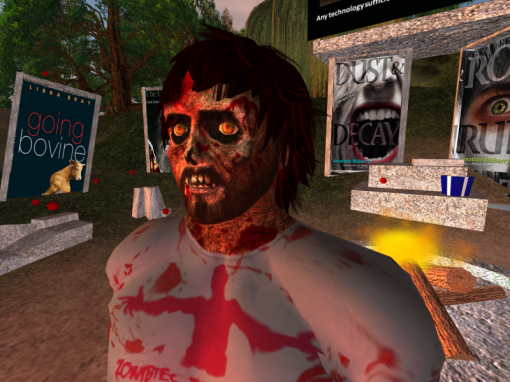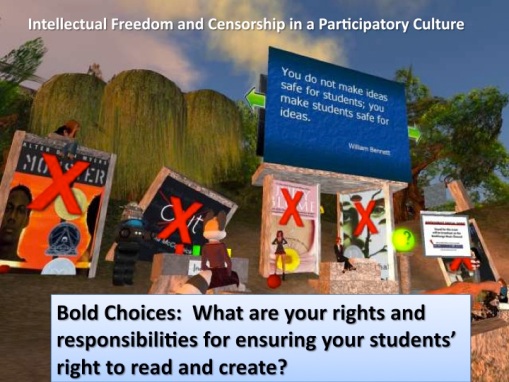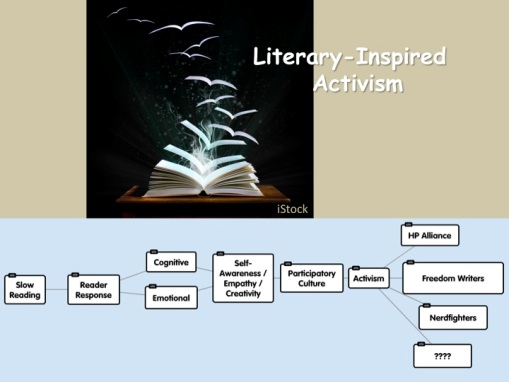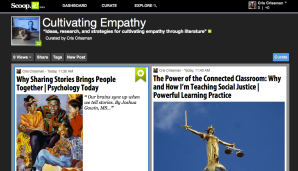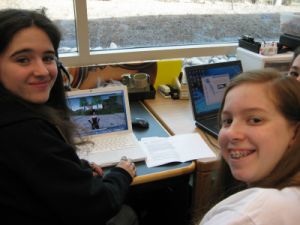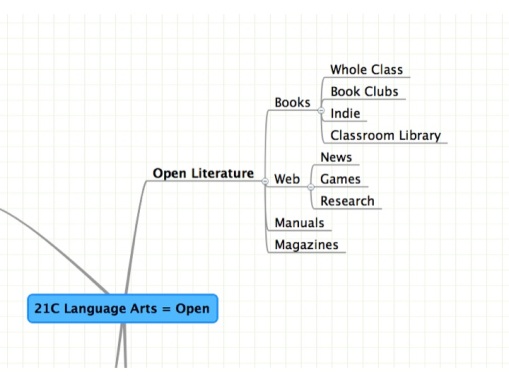We’ve booktalked our Change Project speculative fiction choices. It really was much like an Eva Perry Mock Printz Club meeting only there would be much more chatter since there would be more readers who had read the same books by now and would share their opinions. It’s also fun in the club when we learn about everyone’s literary likes and dislikes and can predict their responses. Some love to dis a book with quite the drama ;-).

All of our books are dystopian, though interestingly, Ashley noted that M.T. Anderson’s Feed wasn’t the result of some apocalypse as the others. Perhaps Bradley’s Human.4 might fit in that category of an evolutionary dystopian novel, too.
One of our challenges in reviewing the books was to find one or more that could make good additions to Kim’s Project Justice. Project Justice is a creative, inspiring middle school project on learning about social justice, what contributions other young people have made towards working for social justice, interviewing community leaders to see what the needs may be, and creating and implementing a project themselves. What we felt might make a contribution would be some compelling YA books, fiction or nonfiction, that could inspire students to think deeply about important issues, perhaps through the eyes of someone far different from themselves.
Here are the books we discussed with links to wikis with resources for each book. Kim, we found two books that look promising for your project — The Last Book in the Universe and Human.4. See what you think!
The Adoration of Jenna Fox by Mary Pearson presented by Meg
“As Jenna discovers the truth about the year she was sleeping and attempts to find her place in the world in the aftermath of that truth, Pearson confronts the reader with difficult questions about the nature of life and humanity. The Adoration of Jenna Fox not only asks the reader to think about what makes us human and where our humanity lies, but also to quantify the issue. What percentage of a person can you replace and still call them human?” — Meg
Feed by M. T. Anderson presented by Ashley
“The ultimate social justice message of this novel is mindfulness. Titus’s society got to be the way it is because people weren’t mindful – of the environment, of their consumerism, of politics. While some of the consequences may seem extreme, Anderson’s point is quite clear: we need to pay attention.” — Ashley
Genesis by Barnard Beckett presented by Michele
“Genesis belongs on the shelf of every high school science teacher. In fact, it is my husband’s winter reading assignment (per me), and I am almost certain it will become the new class novel for his Future Decisions in Science course. It raises so many interesting questions about evolution, humanity, artificial intelligence, and the destruction of our planet’s ecosystems. While the philosophical questions raised by the novel will probably make it a tough journey for reluctant readers, it will enthrall the STEM-oriented students in the room and will help them consider issues that will inevitably come up in their future careers.” — Michele
*Human.4 by Mike A. Lancaster presented by Bradley
“The story seems to comment largely on the ideas of the digital divide that exists in our current society. The gap between those who have the technology and those who don’t. The story comments on living different existences because of the divide and what it is like to live without. There are many possible ways of discussing this issue that develops within the story and it would make an interesting class topic to discuss.” — Bradley
*The Last Book in the Universe by Rodman Philbrick presented by Cris
“This story mirrors what is happening in our current world far too well to leave any reader unaffected. With an uber-rich, elite class emerging while others suffer from poverty and lack of opportunity, Phibrick tells a post-apocalyptic-dystopian story that forces us to consider the essence of what it means to be human and what are the basic human rights. Social justice means equal opportunity to what it takes to not only survivebut live in hope and believe in a future.” — Cris
The Uglies by Scott Westerfield presented by Annie
“For me, the novel’s power–and I believe rise to acclaim–lies in Westerfield’s aility to do so much so effectively.
Not only does he tackle the issue of uniqueness being a positive thing, and attractiveness being largely culturally-bound, but he also forces readers to question whether other social constructs are empowering, limiting, or both.
How much freedom do any of us have?
Westerfeld, in short, poses the age old rhetorical question of “if your dreams came true, would you be better for it?” with a shockingly new–and dystopian–twist.” — Annie
Interesting aside, Westerfeld has written a commentary on dystopian novels in which he describes the power and control issues as of particular interest to teens. He defines a dystopian novel as “usually about a society [often post-apocalyptic) where individuals have almost no freedom. The characters in these novels must fight against the status quo and because the authoritarian control is total, they’re always the underdog. We root for them to win in their struggle, while being thankful our world is not so harsh or creepy! In a weird way, these stories make us feel good about our future, because if they can fight, survive, and overcome, well, then so can we when we face completely normal, regular-world junk.”
Prepping for Maberry UNDEAD
We’ve gathered, discussed, and prioritized questions for Jonathan into four categories: Jonathan’s Writing Life, His YA Books, His Take on DysLit (Dystopian Literature), and His Teaching of Writing. More on our plans for the event will be in the Welcome to Session 14 post.
